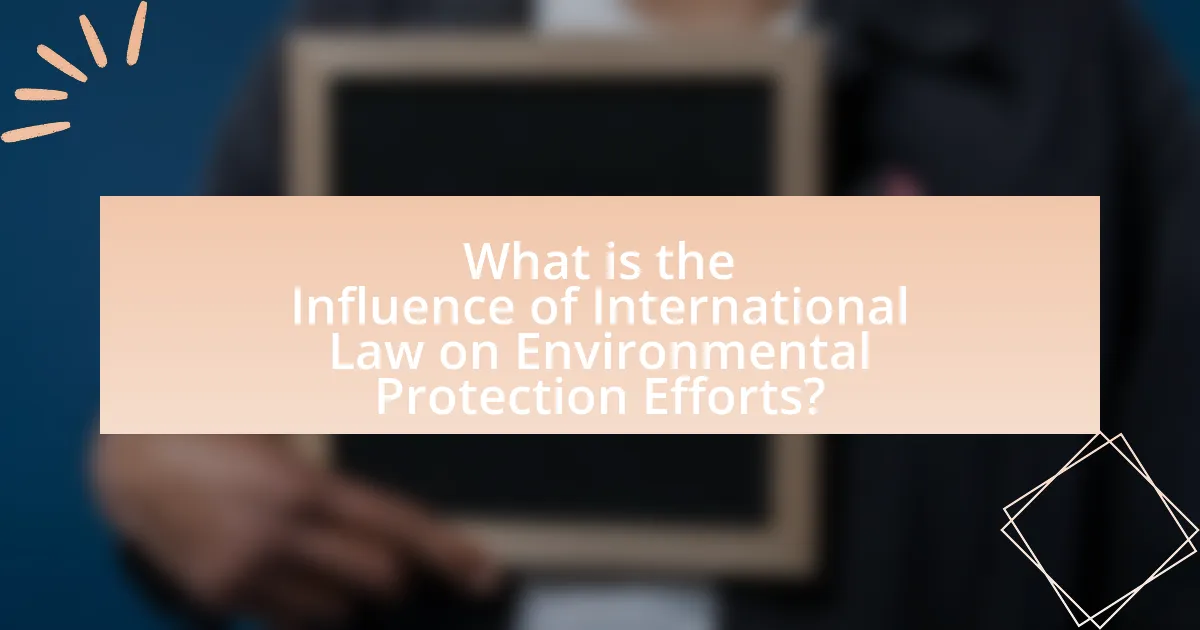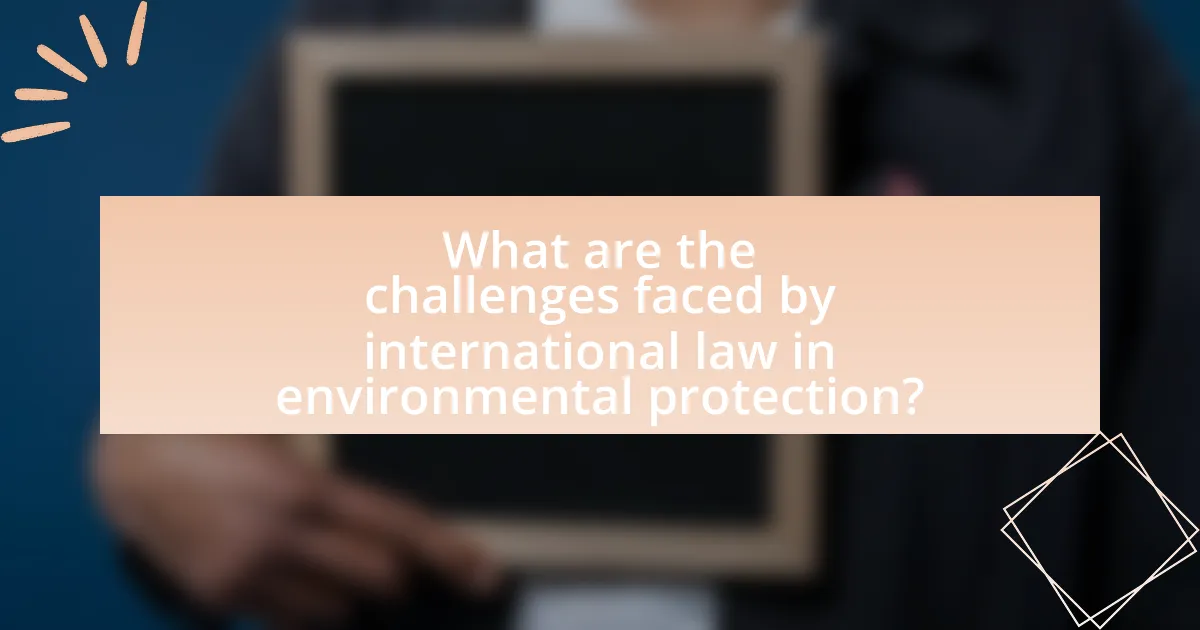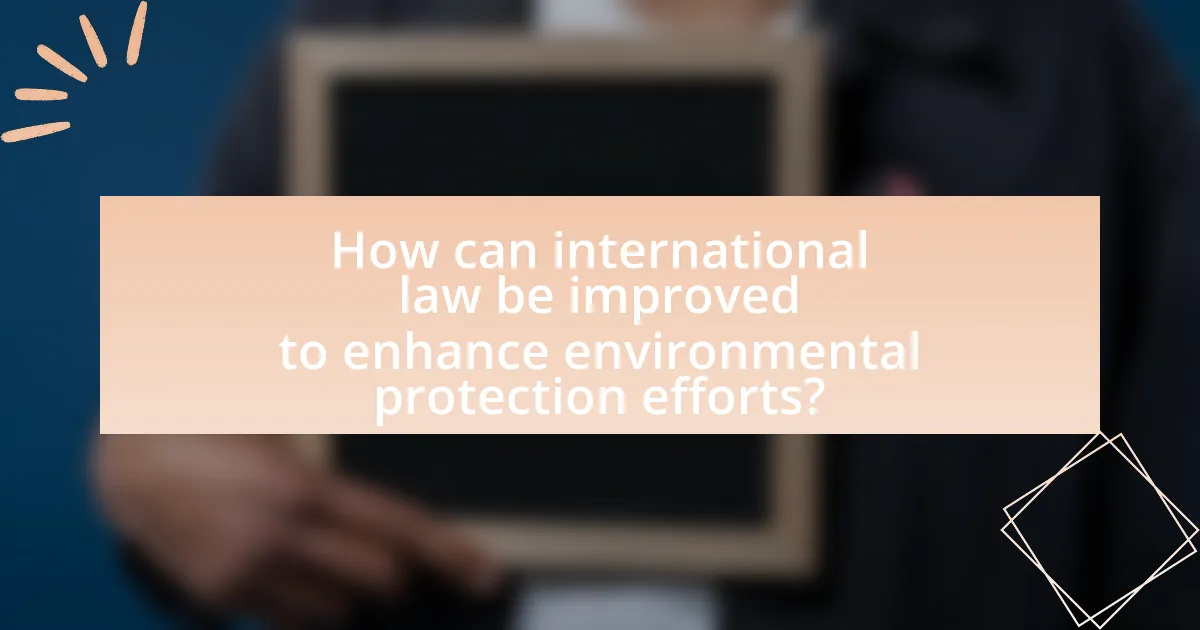The article examines the significant influence of international law on environmental protection efforts, highlighting key treaties such as the Paris Agreement and the Convention on Biological Diversity. It discusses how these legal frameworks establish binding obligations for countries, promote cooperation, and enhance accountability in addressing global environmental challenges. The article also addresses the enforcement mechanisms, compliance issues, and the role of international organizations in environmental governance, while exploring the impact of globalization and economic factors on treaty commitments. Additionally, it identifies the limitations of current legal frameworks and suggests innovative approaches to strengthen international environmental agreements.

What is the Influence of International Law on Environmental Protection Efforts?
International law significantly influences environmental protection efforts by establishing binding agreements and frameworks that govern state behavior regarding environmental issues. Treaties such as the Paris Agreement and the Convention on Biological Diversity create obligations for countries to reduce greenhouse gas emissions and protect biodiversity, respectively. These international legal instruments facilitate cooperation among nations, promote sustainable practices, and provide mechanisms for accountability and enforcement. For instance, the Paris Agreement, adopted in 2015, commits its signatories to limit global warming to well below 2 degrees Celsius, demonstrating how international law can drive collective action towards environmental sustainability.
How does international law shape environmental policies globally?
International law shapes environmental policies globally by establishing binding agreements and frameworks that govern state behavior regarding environmental protection. Treaties such as the Paris Agreement and the Convention on Biological Diversity create obligations for countries to reduce greenhouse gas emissions and conserve biodiversity, respectively. These international legal instruments provide a platform for cooperation, enabling nations to set common goals and share best practices, which enhances the effectiveness of national policies. For instance, the Paris Agreement, adopted in 2015, commits its parties to limit global warming to well below 2 degrees Celsius, influencing domestic legislation and climate action plans across multiple countries.
What are the key treaties and agreements in international environmental law?
The key treaties and agreements in international environmental law include the United Nations Framework Convention on Climate Change (UNFCCC), the Kyoto Protocol, the Paris Agreement, the Convention on Biological Diversity (CBD), and the United Nations Convention to Combat Desertification (UNCCD). These treaties establish frameworks for international cooperation to address environmental issues such as climate change, biodiversity loss, and land degradation. For instance, the Paris Agreement, adopted in 2015, aims to limit global warming to well below 2 degrees Celsius, with countries committing to nationally determined contributions (NDCs) to reduce greenhouse gas emissions. The Convention on Biological Diversity, established in 1992, focuses on the conservation of biological diversity, sustainable use of its components, and fair sharing of benefits arising from genetic resources.
How do these treaties enforce compliance among nations?
Treaties enforce compliance among nations through mechanisms such as monitoring, reporting requirements, and sanctions for non-compliance. For instance, the Paris Agreement establishes a framework for countries to set and report on their greenhouse gas emissions targets, fostering transparency and accountability. Additionally, treaties often include provisions for financial assistance and technology transfer to support compliance, as seen in the Kyoto Protocol, which incentivizes nations to meet their commitments by providing resources for sustainable development. These structured approaches create a system of mutual obligation and peer pressure, encouraging nations to adhere to their environmental commitments.
Why is international cooperation essential for environmental protection?
International cooperation is essential for environmental protection because environmental issues often transcend national borders and require collective action to address effectively. For instance, climate change, biodiversity loss, and pollution are global challenges that no single country can solve alone. The Paris Agreement, adopted by 196 countries, exemplifies how international collaboration can set binding targets for reducing greenhouse gas emissions, demonstrating that unified efforts are crucial for achieving significant environmental outcomes. Furthermore, studies indicate that transboundary pollution, such as acid rain, can only be mitigated through cooperative frameworks, as evidenced by the 1979 Convention on Long-Range Transboundary Air Pollution, which has led to substantial reductions in harmful emissions across Europe. Thus, international cooperation is vital for creating comprehensive strategies and legal frameworks that facilitate effective environmental protection on a global scale.
What role do international organizations play in environmental governance?
International organizations play a crucial role in environmental governance by establishing frameworks for cooperation, setting standards, and facilitating the implementation of environmental policies among nations. They provide platforms for dialogue, negotiation, and consensus-building, which are essential for addressing transboundary environmental issues such as climate change, biodiversity loss, and pollution. For instance, the United Nations Environment Programme (UNEP) coordinates global efforts to promote sustainable development and environmental protection, while the Intergovernmental Panel on Climate Change (IPCC) assesses scientific information related to climate change, guiding international policy decisions. These organizations also monitor compliance with international agreements, such as the Paris Agreement, ensuring that countries adhere to their commitments and fostering accountability in environmental governance.
How does globalization impact environmental law and protection efforts?
Globalization significantly impacts environmental law and protection efforts by facilitating international cooperation and the establishment of transnational legal frameworks. This interconnectedness allows countries to collaborate on environmental issues, leading to agreements such as the Paris Agreement, which aims to combat climate change through collective action. Furthermore, globalization promotes the sharing of technology and best practices for environmental protection, enhancing the capacity of nations to implement effective laws. For instance, the Global Environment Facility has funded numerous projects worldwide, demonstrating how international financial support can bolster local environmental initiatives.

What are the challenges faced by international law in environmental protection?
International law faces several challenges in environmental protection, primarily due to issues of enforcement, jurisdiction, and compliance. Enforcement is problematic because international treaties often lack binding mechanisms, making it difficult to hold states accountable for violations. Jurisdictional challenges arise when environmental issues cross national borders, complicating the ability of any single nation to regulate effectively. Additionally, compliance is hindered by varying levels of commitment and capacity among countries, particularly between developed and developing nations, which can lead to unequal implementation of environmental standards. These challenges are evidenced by the limited success of international agreements like the Kyoto Protocol, where many signatory countries failed to meet their emission reduction targets.
How do differing national interests affect international environmental agreements?
Differing national interests significantly hinder the effectiveness of international environmental agreements. Countries prioritize their economic growth, energy needs, and political agendas, often leading to conflicting positions on environmental regulations. For instance, during the Paris Agreement negotiations, developed nations advocated for stringent emission reductions, while developing countries emphasized their right to economic development, resulting in compromises that diluted the agreement’s overall impact. This divergence illustrates how national priorities can shape the commitments made in international treaties, often leading to weaker enforcement and compliance mechanisms.
What are the consequences of non-compliance with international environmental laws?
Non-compliance with international environmental laws can lead to severe consequences, including legal penalties, economic sanctions, and reputational damage. Countries that fail to adhere to these laws may face litigation in international courts, resulting in fines or mandated corrective actions. For instance, the European Union has imposed significant fines on member states for failing to meet environmental directives, demonstrating the legal repercussions of non-compliance. Additionally, non-compliant nations may encounter trade restrictions or sanctions from other countries, impacting their economies. The reputational damage can deter foreign investment and harm diplomatic relations, as seen in cases where countries have been publicly criticized for environmental negligence. These consequences underscore the importance of adherence to international environmental laws for maintaining global cooperation and sustainable development.
How do economic factors influence countries’ commitment to environmental treaties?
Economic factors significantly influence countries’ commitment to environmental treaties by determining the resources available for compliance and the perceived economic benefits of participation. Countries with strong economies are more likely to invest in sustainable practices and technologies, as they can afford the upfront costs associated with meeting treaty obligations. For instance, wealthier nations often have the financial capacity to transition to renewable energy sources, which aligns with international environmental agreements. Conversely, developing countries may prioritize immediate economic growth over environmental commitments due to limited resources, leading to lower compliance rates. Research by the World Bank indicates that nations with higher GDP per capita tend to have stronger commitments to environmental treaties, as they can allocate funds for environmental protection without jeopardizing economic stability.
What are the limitations of current international environmental laws?
Current international environmental laws face significant limitations, including lack of enforcement mechanisms, insufficient binding commitments, and inadequate coverage of emerging environmental issues. Enforcement mechanisms are often weak, as many treaties rely on voluntary compliance, leading to inconsistent implementation among nations. Additionally, many international agreements do not impose legally binding obligations, which diminishes their effectiveness in compelling states to take action. Furthermore, existing laws frequently fail to address new challenges such as climate change, biodiversity loss, and pollution from emerging technologies, leaving critical gaps in environmental protection. These limitations hinder the overall effectiveness of international efforts to safeguard the environment.
How effective are enforcement mechanisms in international environmental law?
Enforcement mechanisms in international environmental law are generally considered to be weak and often ineffective. This ineffectiveness stems from the lack of binding authority and the reliance on voluntary compliance by states, which can lead to inconsistent enforcement and accountability. For instance, the Kyoto Protocol, aimed at reducing greenhouse gas emissions, faced challenges in enforcement as major emitters like the United States withdrew, highlighting the limitations of international agreements without robust enforcement mechanisms. Additionally, the absence of a global environmental court further complicates the enforcement of international environmental laws, as there is no centralized authority to adjudicate disputes or impose penalties.
What gaps exist in the current legal frameworks for environmental protection?
Current legal frameworks for environmental protection exhibit significant gaps, particularly in enforcement, jurisdiction, and adaptability to emerging environmental challenges. Enforcement mechanisms often lack the necessary resources and political will, leading to inadequate compliance with existing regulations. Jurisdictional issues arise when environmental harm crosses national borders, complicating accountability and response efforts. Additionally, many legal frameworks are not sufficiently adaptable to address new threats such as climate change, biodiversity loss, and pollution from emerging technologies. For instance, the United Nations Environment Programme has highlighted that existing treaties often fail to incorporate the latest scientific findings, which undermines their effectiveness in protecting the environment.

How can international law be improved to enhance environmental protection efforts?
International law can be improved to enhance environmental protection efforts by establishing binding agreements that enforce compliance among nations. Strengthening international treaties, such as the Paris Agreement, to include specific, measurable targets and penalties for non-compliance would create accountability. Additionally, integrating environmental considerations into trade agreements can ensure that economic activities do not undermine environmental standards. The effectiveness of international law is evidenced by the success of the Montreal Protocol, which led to the significant reduction of ozone-depleting substances through legally binding commitments from participating countries.
What innovative approaches can strengthen international environmental agreements?
Innovative approaches that can strengthen international environmental agreements include the integration of technology for real-time monitoring and reporting of environmental compliance. Utilizing satellite imagery and data analytics can enhance transparency and accountability among nations, as evidenced by the Global Forest Watch initiative, which uses satellite data to monitor deforestation in real-time. Additionally, incorporating market-based mechanisms, such as carbon trading and biodiversity offsets, can incentivize countries to meet their environmental commitments while fostering economic growth. The Paris Agreement exemplifies this approach by allowing countries to set their own emission reduction targets, promoting flexibility and participation. Furthermore, enhancing public participation and stakeholder engagement in the negotiation process can lead to more robust agreements, as seen in the success of the Aarhus Convention, which emphasizes access to information and public involvement in environmental decision-making.
How can technology be leveraged to monitor compliance with environmental laws?
Technology can be leveraged to monitor compliance with environmental laws through the use of remote sensing, data analytics, and real-time monitoring systems. Remote sensing technologies, such as satellites and drones, provide comprehensive data on land use, deforestation, and pollution levels, enabling authorities to detect violations of environmental regulations. Data analytics tools can process large datasets to identify trends and anomalies in environmental data, facilitating proactive compliance checks. Real-time monitoring systems, including IoT sensors, allow for continuous tracking of emissions and waste management practices, ensuring adherence to legal standards. For instance, the European Space Agency’s Copernicus program utilizes satellite imagery to monitor air quality and land changes, demonstrating the effectiveness of technology in enforcing environmental laws.
What role does public participation play in shaping international environmental law?
Public participation plays a crucial role in shaping international environmental law by ensuring that diverse stakeholder perspectives are considered in the decision-making process. This involvement enhances the legitimacy and effectiveness of environmental policies, as seen in the Aarhus Convention, which emphasizes access to information, public participation in decision-making, and access to justice in environmental matters. Studies indicate that inclusive public engagement leads to more sustainable outcomes, as it fosters transparency and accountability, ultimately influencing the formulation and implementation of international environmental agreements.
What best practices can be adopted for effective international environmental governance?
Effective international environmental governance can be achieved through the adoption of collaborative frameworks, transparent decision-making processes, and robust enforcement mechanisms. Collaborative frameworks, such as the Paris Agreement, facilitate cooperation among nations to address climate change collectively, demonstrating that multilateral efforts can lead to significant environmental outcomes. Transparent decision-making processes, exemplified by the Aarhus Convention, ensure public participation and access to information, which enhances accountability and trust in governance. Additionally, robust enforcement mechanisms, like those established by the Convention on Biological Diversity, provide the necessary tools for compliance and accountability, ensuring that countries adhere to their environmental commitments. These practices collectively contribute to a more effective and equitable approach to international environmental governance.
How can countries collaborate to share resources and knowledge for environmental protection?
Countries can collaborate to share resources and knowledge for environmental protection through international agreements and partnerships. For instance, treaties like the Paris Agreement facilitate the exchange of technology and funding to combat climate change, enabling nations to work together on sustainable practices. Additionally, organizations such as the United Nations Environment Programme (UNEP) promote collaborative initiatives, providing platforms for countries to share best practices and research findings. Evidence of successful collaboration includes the Global Environment Facility, which has funded over 4,500 projects in more than 170 countries, demonstrating the effectiveness of shared resources in addressing environmental challenges.
What strategies can be implemented to raise awareness about international environmental laws?
To raise awareness about international environmental laws, educational campaigns targeting diverse audiences can be implemented. These campaigns should utilize various platforms, including social media, workshops, and community events, to disseminate information about the significance and implications of these laws. For instance, the United Nations Environment Programme (UNEP) has successfully conducted initiatives that engage local communities and stakeholders, demonstrating the effectiveness of grassroots involvement in raising awareness. Additionally, collaboration with educational institutions to integrate environmental law into curricula can foster a deeper understanding among students, ensuring that future generations are informed about these critical regulations.
What practical steps can individuals take to support international environmental efforts?
Individuals can support international environmental efforts by adopting sustainable practices in their daily lives. This includes reducing waste through recycling and composting, conserving energy by using energy-efficient appliances, and minimizing water usage. Additionally, individuals can advocate for environmental policies by participating in local and global campaigns, supporting organizations focused on environmental protection, and educating others about the importance of sustainability. According to the United Nations Environment Programme, individual actions collectively contribute to significant environmental improvements, demonstrating that personal responsibility plays a crucial role in global efforts to combat climate change and protect biodiversity.